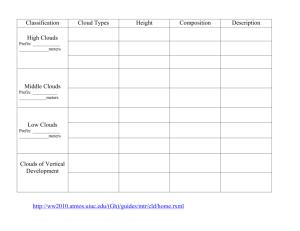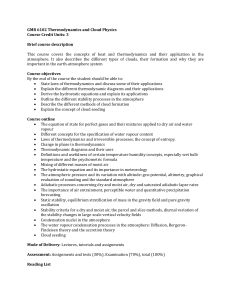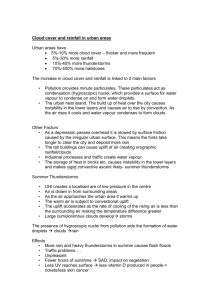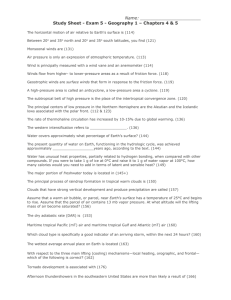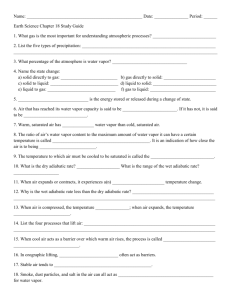Numerical Weather Prediction Parametrization of
advertisement
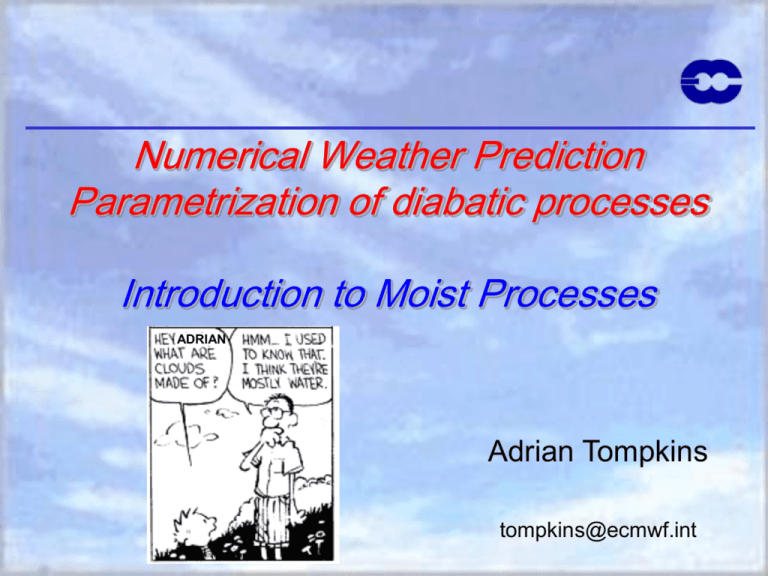
Numerical Weather Prediction Parametrization of diabatic processes Introduction to Moist Processes ADRIAN Adrian Tompkins tompkins@ecmwf.int Clouds Water in the atmosphere can be present in all three phases: vapour, liquid and solid Clouds, water in the form of liquid or ice, play an crucial role in the earth’s climate Clouds and the precipitation formed in them are important forecast products Clouds - why are they important? Clouds are a common atmospheric feature and cover large parts of the globe What is the mean coverage? Latent heat release or consumption occur either directly in clouds or in the precipitation produced in them. Clouds - Why are they important? The entire model hydrological cycle will depend on the representation of clouds and their microphysical processes Cloud radiative effects (“forcing”) TOA- ERBE - JJA 87 Clouds - Why are they important? They strongly affect the radiative fluxes throughout the atmosphere Sherwood et al JGR 1994, show that the tropical circulation is strongly influenced by the interaction between radiation and clouds LWCRF L Lclr SWCRF S Sclr CRF LWCRF SWCRF Clouds and Convection in GCMs What are the problems ? Many clouds and especially the processes within them are of subgrid-scale size (both horizontally and vertically) and thus must be parameterized. This means a mathematical model is constructed that attempts to assess their effects in terms of the Large-scale model resolved quantities. The aim of this course component is to introduce a few of the approaches used for this important task GCM Grid cell 20-400km T,q,u,v,w... Clouds in GCMs - What are the problems ? stratocumulus There is a huge variety of cloud types cirrus cumulus/cumulonimbus http://australiasevereweather.com/photography In this course, we will consider: composite infra-red image Warm and ice phase microphysics This schematic of a front illustrates the interactions involved In this course, we will consider: Stratocumulus Why are they dark? Clouds in GCMs - What are the problems ? Stratocumulus Driven by turbulence in the boundary layer Very common, particularly over the oceans near the west Coast of the major continents Difficult to model: formation, regime (cloud cover), decoupling, break up… one of the common deficiencies of climate and forecast models Schematic: StCu to Cu Transition destabilization: zi • surface buoyancy flux • atmos. radiative cooling • uplift (cooling, moistening) • convergence • shear zcb zi dry BL Stratocumulus Shallow cumulus Deep cumulus Figure from Martin Koehler Cloud Cover JJA Total Cloud Cover 90°W ehh2 June 2001 nmonth=3 Glob Mean: 90°E 59.2 50N-S Mean: 56.7 135°W 45°W 0° 45°E 135°E DJF Total Cloud Cover ehh2 December 2000 nmonth=3 Glob Mean: 62.2 50N-S Mean: 59.3 135°W 90°W 45°W 0° 45°E 90°E 135°E [percent] 99.80 60°N 60°N 99.45 60°N 60°N 65 35 95 30°N 30°N 65 80 95 30°N 65 0° 65 65 65 65 0° 0° 65 35 65 50 30°S 35 65 60°S 90°W 45°W 0° 45°E 90°E 30°S 65 20 60°S 60°S 135°W 90°W 45°W 0° 45°E 90°E 135°E Total Cloud Cover 90°W ISCCP D245°WDecember 2000 nmonth=3 50N-S Mean: 62.9 135°W 0° 45°E 90°E 135°E [percent] [percent] 99.47 60°N 60°N 65 65 97.41 60°N 60°N 95 95 95 30°N 30°N 35 80 30°N 30°N 65 65 80 65 65 65 65 0° 0° 65 0° 30°S 65 0° 65 65 50 30°S 35 65 65 35 65 35 65 65 50 65 30°S 30°S 65 65 65 35 35 95 60°S 60°S 20 60°S 60°S 5 135°W 90°W 45°W 0° 45°E 90°E 135°W 90°W 45°W 0° 45°E 90°E 135°W 90°W 45°W 0° 45°E 90°E 135°E Difference ehh2 - ISCCP 50N-S Mean err -3.64 50N-S rms 12.9 135°E 135°W 90°W 45°W 0° 45°E 90°E 135°E [percent] [percent] 43.03 60°N 20 9.090 135°E Difference ehh2 - ISCCP 50N-S Mean err -4.74 50N-S rms 14 Difference 20 5.751 135°E Total Cloud Cover ISCCP45°WD2 June0° 2001 nmonth=3 50N-S Mean: 61.4 135°W 90°W 45°E 90°E 135°E ISCCP D2 35 65 5 95 135°W 30°S 35 60°S 50 35 65 30°S 65 35 65 35 80 65 35 65 0° 30°N 65 65 35 ECMWF [percent] 60°N 42.42 60°N 60°N 40 40 -20 30 30°N 30°N 30 30°N 30°N 20 10 -20 20 10 0° 0° 10 -10 10 0° 0° -20 30°S 30°S -20 30°S 30°S -30 -30 -40 10 60°S 60°S -40 60°S 60°S -50 -50 -60 135°W 90°W 45°W 0° 45°E 90°E 135°E -10 -60 135°W 90°W 45°W 0° 45°E 90°E 135°E In this course, we will consider: Cirrus Clouds in GCMs - What are the problems ? Cirrus Ice cloud found in the upper troposphere. e.g: fronts, convective anvils. Important for the radiative impact Microphysics of the ice phase even less well understood than liquid phase In this course, we will consider: Deep and Shallow (un)organised convection Convection In atmospheric science generally restrict the term “convection” to refer to fluid motions resulting from the action of gravity on unstable vertical mass distribution. Encompasses a huge range of scales of organisation: • Turbulent boundary Layers • Deep moist convection - Thunder storms • Squall Lines and Hurricanes Current models do not take organised systems into account Complex interaction of a host of processes Overview of Clouds/Convection • Introduction – Motivation, moist thermodynamics • Parametrization of moist convection (4 lectures, Peter), – Theory of moist convection – Common approaches to parametrization including the ECMWF scheme • Cloud Resolving Models (1 lecture - Adrian) – their use as parametrization tools • Parametrization of clouds (3 lectures - Adrian) – Basic microphysics of clouds – The problem of representing cloud cover – The ECMWF cloud scheme (and issues concerning validation) • Exercise Classes (1 afternoon, Peter and Adrian) Moist Thermodynamics Brief Overview of what we presume you are familiar with, and an introduction to thermodynamic charts For simplified Overview: Rogers and Yau (1989) “A short course in cloud physics” For rigorous definitions: K. A. Emanuel (1994) “Atmospheric Convection” How many have used tephigrams? Moist Thermodynamics • Assume that “moist air” can be treated as mixture of two ideal gases: “dry air” + vapour Density=1/specific volume Dry air equation of state: ( 1 ) pd d RdT Pressure Water Vapour equation of state: Vapour pressure Gas Constant for dry air = 287 J Kg-1 K-1 e v RvT v vapour density Temperature Rd Gas constant for Vapour = 461 J Kg-1 K-1 T 0.622 First law of thermodynamics Heat is a form of energy, and energy is conserved dq du dw Heat supplied by diabatic process (lowercase=per unit mass) Change in internal Energy Can write as dq Cv dT pd Work done by Gas Cv ( ) Specific Heat at constant volume Cp ( ) Specific Heat at constant pressure dq dT dq dT p First law of thermodynamics: form Differentiating the equation of state and using C p Cv Rd dq C p dT dp Special processes: “Adiabatic Process” dq=0 C p dT dp Special significance since many atmospheric motions can be approximated as adiabatic Conserved Variables Using equation of state and integrating, obtain Poisson’s equation p T T0 p0 Rd Cp Setting reference pressure to 1000hPa gives the definition of potential temperature (Note: for dry air) p0 T p Rd C p Meteorological energy diagrams Total heat added in cyclic process: dq C T p Rd dp Cp p C Td (ln ) p rotate to have pressure (almost) horizontal Thus diagram with ordinates T versus ln will have the properties of “equal areas”=“equal energy” Called a TEPHIGRAM dT T The Clausius-Clapeyron equation air+water vapour water Consider this closed system in equilibrium: T equal for water & air, no net evaporation or condensation Air is said to be saturated • For the phase change between water and water vapour the equilibrium pressure (often called saturation water vapour pressure) is a function of temperature only • with v >> w, and the ideal gas law v=RvT/es des 1 Lv dT T ( v w ) des Lv es dT RvT 2 The Clausius-Clapeyron equation Integration • The problem of integrating the Clausius-Clapeyron equation lies in the temperature dependence of Lv. • Fortunately this dependence is only weak, so that approximate formulae can be derived. es L 1 1 ln es 0 Rv T0 T es0 = 6.11 hPa at T0=273 K Nonlinearity has consequences for mixing in convection Humidity variables There are a number of common ways to describe vapour content : 1. Vapour Pressure, e Pa 2. Absolute humidity kg m 3 3. Specific humidity kg kg 1 Mass of water vapour per moist air mass 4. Mixing ratio 5. Relative humidity kg kg 1 v v e e q pe p v e e r d p (1 )e p e r RH (sometimes ) es rs Tephigram (II) T Saturation specific humidity r es qs p es Saturation mixing ratio es rs p (1 )es pressure Function of temperature and pressure only – tephigrams have isopleths of rs Using a Tephigram At a pressure of 950 hPa Measure T=20 oC r=10 gkg-1 plot a atmospheric sounding Virtual temperature Tv Another way to describe the vapour content is the virtual temperature , an artificial temperature. It describes the temperature dry air would have to have in order to have the same density as a sample of moist air By extension, we define the virtual potential temperature, which is a conserved variable in unsaturated ascent, and related to density 1 r v p pd e Rd T ( d ) Rd T 1 r 1 r Tv T T (1 0.608r ) 1 r p0 v Tv p Rd C p Water variables • absolute liquid water content l • liquid water mixing ratio l rl d kg kg 1 • total water mixing ratio rt rv rl kg kg 1 • specific liquid water content l ql kg kg 1 Analogous to Tv can define the density temperature T, which is the T dry air would have to have equal density to moist cloudy air kg m 3 1 r T T 1 rt How can we saturate a parcel of air? The description of water content in its liquid (and/or ice) state Ways of reaching saturation Several ways to reach saturation: All of these are important cloud processes!!! • Diabatic Cooling (e.g. Radiation) • Evaporation (e.g. of precipitation) • Expansion (e.g. ascent/descent) Cooling: Dew point temperature Td Temperature to which air must be cooled to reach saturation, with p and r held constant Evaporation: Wet-bulb temperature Tw C pmdT Lv dr Lv dr C p dT Lv dr 1 r (1 r )(1 0.9r ) Temperature to which air may be cooled by evaporation of water into it until saturation is reached, at constant p Will show how to determine graphically from tephigram Ways of reaching saturation: Expansion: (Pseudo) Adiabatic Processes As (unsaturated) moist air expands (e.g. through vertical motion), cools adiabatically conserving . Eventually saturation pressure is reached, T,p are known as the “isentropic condensation temperature and pressure”, respectively. If expansion continues, condensation will occur (assuming that liquid water condenses efficiently and no super saturation can persist), thus the temperature will decrease at a slower rate. Ways of reaching saturation: Expansion: (Pseudo) Adiabatic Processes Have to make a decision concerning the condensed water. • Does it falls out instantly or does it remain in the parcel? If it remains, the heat capacity should be accounted for, and it will have an effect on parcel buoyancy • Once the freezing point is reached, are ice processes taken into account? (complex) These are issues concerning microphysics, and dynamics. The air parcel history will depend on the situation. We take the simplest case: all condensate instantly lost as precipitation, known as “Pseudo adiabatic process” Pseudo adiabatic process Tephigram (III) T For a pseudoadiabatic process: r 0 dq C p dT dp Lv drs gives: dp Lv dT kT drs p Cp pressure Pseudoadiabat Remember: Involves an arbitrary “cloud model” (or moist adiabat) parcel mixing ratio=5g/kg Cooling: (Isobaric process) gives dew point temperature Expansion, (adiabatic process) gives condensation temperature Wet Bulb Temperature Raise parcel pseudoadiabatically until all humidity condenses and then descend dry adiabatically to reference pressure Equivalent Potential temperature e e Lv rv c pT conserved in adiabatic motions Parcel at 850 hPa, T=12.5oC r=6 g/kg Te e (=315K) Summary: Conserved Variables (approximately, r.e. Emanuel 1994) Dry adiabatic processes Moist adiabatic processes potential temperature equivalent potential temperature p0 T p Rd cp dry static energy s c pT gz water vapour mixing ratio rv e e Lv rv c pT moist static energy h c pT gz Lv rv total water mixing ratio rt rv rl Practice! 1. Plot an air parcel at 750 hPa which has T=10C q=2 g kg-1 State the dew-point temperature 2. If it is subjected to forced ascent, State the pressure at which it saturates 3. The parcel continues to rise pseudoadiabatically to 200hPa, what is its temperature and humidity (r) there? 4. The parcel then descends back to 750hPa, what is the final temperature and r? Practice! Results 1 - 10 of about 6,060,000 for practice makes perfect [definition]. (0.05 seconds) 1. The environment at 750 hPa has T=10C and r=2 g kg-1. A saturated thermal arrives at this level with the temperature T=5C and entrains the environmental air with equal ratios (1-1), what is the T/r of the mixed parcel? 2. Then precipitation falling through the layer evaporates and brings this new parcel to saturation, what is the temperature? Jonglers, Salsa Sunday Evenings, Lessons all levels (19.30? £?) free dancing after Indian Restaurant Jazz club – free live music on Thurs Iguana: Coffee+cocktails (upstairs) “Sweenie and Todds” Pie Pub Station “Thai corner” – family run Thai food “3Bs” (basement under town hall) – Free music Thurs, great guest beers If the Weather is nice, don’t forget to take a walk by Thames, off the top of this map, or take a train to Pangbourne or Goring nearby and see the Thames there Abbey Ruins, Reading’s (only) historical part! HobGoblin, smoky - but character pub “Beijing noodle house” – Chinese food, family run see also www.reading-guide.co.uk For Music listings: pick up “Bla Bla” Wagamamas (Oracle by canal), Asian noodle Chain, not bad thoughAfter Dark, grungy nightclub “RISK”: Salsa 19.30 lessons £5/9, free dancing after 21:30 Tuesday (upstairs) International drinks ARTS cinema at Reading University, Tues/Thurs, see readingfilmtheatre.co.uk For London theatre, check out OFFICIAL half-price ticket booth in Leicester Square Finally: A few Unofficial Social Tips… Answer Sheet for Lesson 1 Sheet 1 • Td = -10oC • 550 hPa • T= -78oC For the humidity it is not possible to read from this tephigram. Therefore you have to use the Clausius Clapeyron equation and the definition of mixing ratio to find q=6x10-6 kg kg-1 using T=-78oC and p=200 hPa 4. T=15oC, so the parcel has gained 5oC from the latent heating released by the condensation process. Since humidity is conserved then q =6x10-6 kg kg-1 Sheet 2 1. T=12.5oC and q=4.7 g kg-1. Note that the humidity scale is not linear! 2. T=4oC
